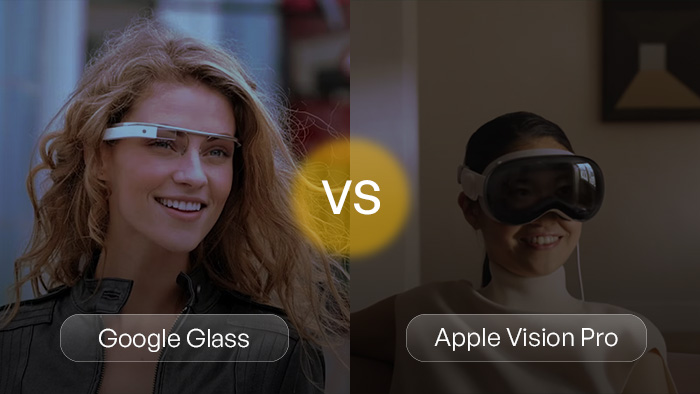

The world of wearable technology has witnessed remarkable advancements, pushing the boundaries of innovation and transforming the way we interact with the digital realm. Two prominent players in this space, Apple and Google, have each made significant contributions with their respective smart glasses: Apple Vision Pro and Google Glass. In this blog, we delve into a comparative analysis of these two groundbreaking technologies, examining the lessons learned from the past and the future possibilities they offer. Join us on this exploration as we navigate the exciting landscape of wearable tech, discovering how Apple Vision Pro and Google Glass shape the future of augmented reality and redefine our digital experiences.
When it comes to design, both Apple Vision Pro and Google Glass showcase distinct approaches. Apple’s meticulous attention to detail is evident in the sleek and stylish design of Vision Pro, seamlessly integrating with modern fashion sensibilities. On the other hand, Google Glass, with its minimalist and futuristic look, made an early foray into the wearable tech market. While personal preferences may vary, the refined aesthetics of Apple Vision Pro exude elegance, making it an appealing choice for fashion-conscious individuals.
Augmented reality is the backbone of both Apple Vision Pro and Google Glass, allowing users to overlay digital information onto their real-world environment. However, Apple’s ARKit framework provides a more robust and refined AR experience, leveraging the power of Apple’s ecosystem. Vision Pro offers enhanced tracking, realistic rendering, and advanced spatial mapping, resulting in immersive and lifelike AR experiences. Google Glass, while pioneering AR wearables, faced limitations in processing power and graphical capabilities, leading to a more rudimentary AR experience.
Apple’s commitment to seamless integration is one of its strongest assets, and Vision Pro is no exception. These smart glasses flawlessly synchronize with iPhones, iPads, and Macs, leveraging the power of the Apple ecosystem. Users can effortlessly access their apps, messages, and services, creating a unified and synchronized experience across devices. Google Glass, on the other hand, relied heavily on cloud-based services and had limited integration with other devices, which hindered the seamless user experience.
Apple’s focus on delivering an intuitive and user-friendly interface is evident in Vision Pro. The gesture-based interactions, intuitive controls, and familiar Apple interface elements ensure a smooth and immersive user experience. Google Glass, although pioneering the concept of smart glasses, faced challenges in user adoption due to a steep learning curve and a less intuitive interface. Apple’s commitment to user-centric design sets Vision Pro apart, offering a more intuitive and engaging user experience.
Privacy and security are critical considerations in the realm of wearable technology. Apple’s strong stance on user privacy and data protection is well-established. Vision Pro prioritizes user privacy, employing robust security measures to safeguard personal information and ensure a secure experience. In contrast, Google Glass faced privacy concerns and scrutiny due to its potential for unauthorized data collection and privacy infringements. The lessons learned from Google Glass have influenced Apple’s approach, emphasizing the importance of privacy and security in wearable tech.
While Google Glass made significant strides in shaping the wearable tech landscape, it faced challenges in achieving widespread adoption. However, the lessons learned from Google Glass have paved the way for Apple Vision Pro to thrive. With Apple’s vast ecosystem, refined design, enhanced AR capabilities, and focus on user experience, Vision Pro holds immense potential for broader adoption and integration into various industries and everyday life.
Here’s a table representation comparing Apple Vision Pro and Google Glass across various key aspects:
| Aspect | Apple Vision Pro | Google Glass |
| Design and Aesthetics | Sleek, stylish, and modern | Minimalist and futuristic |
| Augmented Reality Capabilities | Enhanced tracking, realistic rendering, advanced mapping | Basic AR experience |
| Integration with Ecosystem | Seamless integration with Apple devices | Limited integration with other devices |
| User Experience and Interface | Intuitive gesture-based controls, familiar Apple interface | Steep learning curve, less intuitive interface |
| Privacy and Security | Strong focus on user privacy and data protection | Privacy concerns and scrutiny |
| Future Potential and Adoption | High potential for broader adoption and industry integration | Faced challenges in achieving widespread adoption |
The comparison between Apple Vision Pro and Google Glass highlights the evolution and progress in wearable technology. Apple’s meticulous design, seamless integration, intuitive interface, and commitment to privacy and security set Vision Pro apart as a formidable contender in the smart glasses arena. By learning from the past, Apple has harnessed the power of augmented reality, shaping a future where wearable tech becomes an integral part of our lives. As we embark on this exciting journey, we eagerly anticipate the advancements, innovations, and transformative experiences that Apple Vision Pro and similar technologies will bring, enhancing our digital interactions and unlocking new realms of possibility.
OpenAI DevDay showcases the latest AI innovations, pushing technology’s boundaries in an ever-evolving landscape.
Explore the top 10 database types for software projects, their unique features, and which one…
Explore PWAs: Your FAQs Guide to Integrating Camera, Geolocation & Device APIs. Harness native features…
General Understanding of PWAs and SEO 1. What is a Progressive Web App (PWA)? A…
Understanding Offline-First Approach Basics 1. What is the concept of "Offline-First" in the context of…
General Overview 1. What are cross-platform frameworks, and how do they relate to Progressive Web…